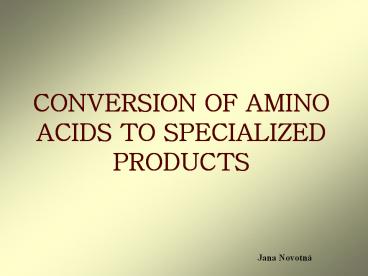Prezentace aplikace PowerPoint - PowerPoint PPT Presentation
Title:
Prezentace aplikace PowerPoint
Description:
CONVERSION OF AMINO ACIDS TO SPECIALIZED PRODUCTS Jana Novotn a-nitrogen atom of amino acids is a primary source for many nitrogenous compounds: Heme Purines and ... – PowerPoint PPT presentation
Number of Views:79
Avg rating:3.0/5.0
Title: Prezentace aplikace PowerPoint
1
CONVERSION OF AMINO ACIDS TO SPECIALIZED PRODUCTS
Jana Novotná
2
a-nitrogen atom of amino acids is a primary
source for many nitrogenous compounds Heme Purin
es and pyrimidines Hormones Neurotransmitters Biol
ogically active peptides
3
Glycine
Glycine is used for heme, purine and creatin
synthesis
a carbon and nitrogen atoms of glycine are used
for synthesis of porphyrine, prosthetic group of
heme.
Take over http//www.rpi.edu/dept/bcbp/molbiochem
/MBWeb/mb2/part1/heme.htm
4
Synthesis of heme
a carbon and nitrogen athoms of glycine are used
for synthesis of porphyrine, prosthetic group of
heme. 1. Condensation of 1 glycine and 1
succinylCoA by the pyridoxal phosphate-containing
enzyme, d-aminolevulinic acid synthase (ALA
synthase) in mitochondria.
Take over http//www.rpi.edu/dept/bcbp/molbiochem
/MBWeb/mb2/part1/heme.htm
5
2. d-aminolevulinic acid (ALA) is transported to
the cytosol. 3. Porfobilinogen synthase (ALA
dehydratase) dimerizes 2 molecules of ALA to
produce the pyrrole ring compound
porphobilinogen. precursor for porphyrine
synthesis
Take over http//www.rpi.edu/dept/bcbp/molbiochem
/MBWeb/mb2/part1/heme.htm
6
Glycine is incorporated intact as constituent of
purines.
7
Synthesis of Creatine and Creatinine
- Creatine nitrogenous organic acid - helps to
supply energy to muscle. - Creatine by way of conversion to and from
phosphocreatine is present and functions in all
vertebrates as energy buffer system. - Kkeeps the ATP/ADP ratio high at subcellular
places where ATP is needed. - The amount of creatinine produced is related to
muscle mass. - The level of creatinine excretion (clearance
rate) is a measure of renal function.
8
Take over http//www.indstate.edu/thcme/mwking/ami
noacidderivatives.html
9
Synthesis of glutathione (GSH)
- Glutathione serves as a reductant is conjugated
to drugs to make them more water soluble
(detoxification). - Reduces peroxides formed during oxygen transport.
The resulting oxidized form of GSH consists of
two molecules disulfide bonded together
(abbreviated GSSG). - Is involved in amino acid transport across cell
membranes (the g-glutamyl cycle). - Serves as a cofactor for some enzymatic reactions
and as an aid in the rearrangement of protein
disulfide bonds.
Take over http//www.rpi.edu/dept/bcbp/molbiochem
/MBWeb/mb1/MB1index.html
10
Tyrosine
- The majority of tyrosine that does not get
incorporated into proteins - is catabolized for energy production.
- is conversion to the catecholamines.
- The catecholamine neurotransmitters are dopamine
norepinephrine, and epinephrine. - Norepinephrine is the principal neurotransmitter
of sympathetic postganglionic endings. - Catecholamines are stored in synaptic knobs of
neurons that secrete it. - Tyrosine is transported into catecholamine-secre
ting neurons and adrenal medullary cells where
catecholamine synthesis takes place.
11
Synthesis of the Catecholamines from Tyrosine
- Tyrosine hydroxylase requires tetrahydrobiopterin
as cofactor. - The hydroxylation reaction generates DOPA.
(3,4-dihydrophenylalanine) - DOPA decarboxylase converts DOPA to dopamine.
- Dopamine b-hydroxylase converts dopamine to
norepinephrine. - Phenylethanolamine N-methyltransferase converts
norepinephrine to epinephrine.
Take over http//themedicalbiochemistrypage.org/a
mino-acid-metabolism.html
12
g-aminobutyric acid (GABA)
- Inhibitory neurotransmitter (CNS).
- Directly regulates muscle tone.
- Its lack leads to convulsions, epilepsia.
- Involved in mechanism of memory.
13
Tryptophan
- Tryptopan serves as the precursor for the
synthesis of serotonin and melatonin - Hydroxylation reaction (tryptophan-5-monooxygenase
) - Decarboxylation (aromatic L-amino acid
decarboxylase) - Acetylation (serotonin N-acetylase)
- Conversion to melatonin (hydroxyindole-O-methyltra
nsferase).
Take of textbook D. L. Nelson, M. M. Cox
Lehninger Principle of Biochemistry. Fourt
Deition.
14
Serotonin and melatonin
- Serotonin is present at highest concentrations in
platelets and in the gastrointestinal tract. - Lesser amounts are found in the brain and the
retina. - Serotonin containing neurons have their cell
bodies in the midline raphe nuclei of the brain
stem. - Proportions of neurons are projected to the
hypothalamus, the limbic system, the neocortex
and the spinal cord. - The released serotonin is recaptured by an
active reuptake mechanism. - Antidepressant, Prozac is to inhibit this
reuptake process. - Synthesis and secretion of melatonin increases
during the dark period of the day. - Concentration maintained at a low level during
daylight hours.
15
Polyamine Biosynthesis
- Conversion of arginine to ornithine.
- Ornithine to putrescine (ornithine
decarboxylase). - Putrescine to spermidine (spermidine synthase,
putrescine aminotransferase). - Spermidine to spermine(Spermidine
aminotranspherase). - SAM s-adenosyl methionine is donor of methyl
group - Polyamines are highly cationic and tend to bind
nucleic acids with high affinity. - Important participants in DNA synthesis, or in
the regulation of that process. - Important modulators of a variety of ion
channels (potassium channel) - Growth factors in both eucaryotic and procaryotic
cells.
Take over http//themedicalbiochemistrypage.org/a
mino-acid-metabolism.html
16
Histidine
- Carnosine is the dipeptide of the amino acids
b-alanine and histidine. - Carnosine is highly concentrated in muscle and
brain tissues. - Scavenger of ROS (radical oxygen species).
- Protection of the peroxidation of cell.
- Membrane fatty acids during oxidative stress.
- Possibly improving Alzheimers disease
through inhibition of growing an aggregates of
b-amiloid proteins in the brain.
Carnosine
17
Histamine
Histamine is derived from the decarboxylation of
the amino acid histidine. Biogenic amine
regulating physiological function in the gut and
acting as a neurotransmitter. Causes several
allergic symptoms. 1) It contributes to an
inflammatory response. 2) It causes
constriction of smooth muscle. 3) Is cause
second type of allergic response (one of the
major causes for asthma)
18
Nitric Oxide NO
- Nitric oxide (NO) is produced by vascular
endothelium and smooth muscle, cardiac muscle,
and many other cell types. - The substrate for NO is L-arginine that is
transported into the cell. - Nitric oxide serves many important functions
- Vasodilation (ligand mediated and flow dependent)
- Inhibition of vasoconstrictor influences (e.g.,
inhibits angiotensin II and sympathetic
vasoconstriction) - Inhibition of platelet adhesion to the vascular
endothelium (anti-thrombotic) - Inhibition of leukocyte adhesion to vascular
endothelium (anti-inflammatory) - Antiproliferative action (e.g., inhibits smooth
muscle hyperplasia following vascular injury) - Scavenging superoxide anion (anti-inflammatory)
19
http//www.rpi.edu/dept/bcbp/molbiochem/MBWeb/mb1/
MB1index.html http//themedicalbiochemistrypage.
org/amino-acid-metabolism.html
Useful webe sites































